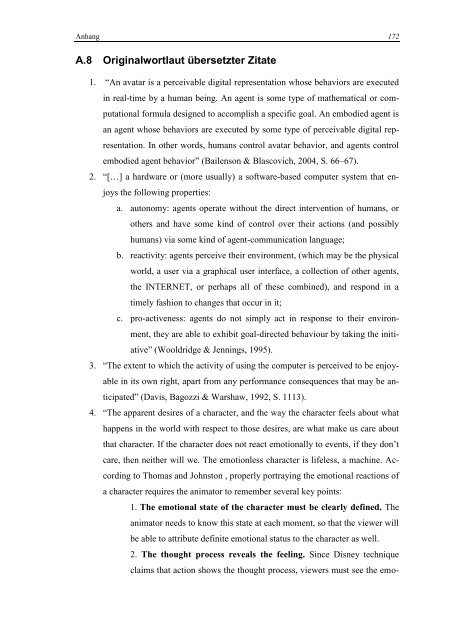Einfluss Emotionaler Intelligenz als Trait und der Big Five ...
Einfluss Emotionaler Intelligenz als Trait und der Big Five ...
Einfluss Emotionaler Intelligenz als Trait und der Big Five ...
Erfolgreiche ePaper selbst erstellen
Machen Sie aus Ihren PDF Publikationen ein blätterbares Flipbook mit unserer einzigartigen Google optimierten e-Paper Software.
Anhang 172<br />
A.8 Originalwortlaut übersetzter Zitate<br />
1. “An avatar is a perceivable digital representation whose behaviors are executed<br />
in real-time by a human being. An agent is some type of mathematical or computational<br />
formula designed to accomplish a specific goal. An embodied agent is<br />
an agent whose behaviors are executed by some type of perceivable digital representation.<br />
In other words, humans control avatar behavior, and agents control<br />
embodied agent behavior” (Bailenson & Blascovich, 2004, S. 66–67).<br />
2. “[…] a hardware or (more usually) a software-based computer system that enjoys<br />
the following properties:<br />
a. autonomy: agents operate without the direct intervention of humans, or<br />
others and have some kind of control over their actions (and possibly<br />
humans) via some kind of agent-communication language;<br />
b. reactivity: agents perceive their environment, (which may be the physical<br />
world, a user via a graphical user interface, a collection of other agents,<br />
the INTERNET, or perhaps all of these combined), and respond in a<br />
timely fashion to changes that occur in it;<br />
c. pro-activeness: agents do not simply act in response to their environment,<br />
they are able to exhibit goal-directed behaviour by taking the initiative”<br />
(Wooldridge & Jennings, 1995).<br />
3. “The extent to which the activity of using the computer is perceived to be enjoyable<br />
in its own right, apart from any performance consequences that may be anticipated”<br />
(Davis, Bagozzi & Warshaw, 1992, S. 1113).<br />
4. “The apparent desires of a character, and the way the character feels about what<br />
happens in the world with respect to those desires, are what make us care about<br />
that character. If the character does not react emotionally to events, if they don’t<br />
care, then neither will we. The emotionless character is lifeless, a machine. According<br />
to Thomas and Johnston , properly portraying the emotional reactions of<br />
a character requires the animator to remember several key points:<br />
1. The emotional state of the character must be clearly defined. The<br />
animator needs to know this state at each moment, so that the viewer will<br />
be able to attribute definite emotional status to the character as well.<br />
2. The thought process reve<strong>als</strong> the feeling. Since Disney technique<br />
claims that action shows the thought process, viewers must see the emo-


